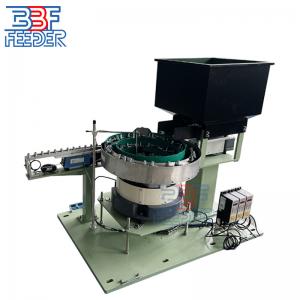
Add to Cart
Vibratory Bowl Feeder Automatic Iron Plate Steel Pipe Vibration Bowl Feeder Bolts
1 . Descriptions:
Vibratory bowl feeders are widely utilized across industries to automate complex production processes by efficiently feeding parts and materials of various configurations. However, like any mechanical device, these feeders can experience damage from prolonged usage and extreme conditions, resulting in unexpected failures that disrupt production and necessitate costly repairs.
If you encounter frequent issues with your vibratory feeder and it fails to perform as expected, it is important to conduct thorough checks before considering repair options.
Key areas to investigate in a damaged vibratory feeder:
Verify that the bowls, track, and hopper pans are operating independently, without making contact with the mounting plate or brackets.
Examine for the presence of dirt or contaminants that may obstruct smooth functioning and cause clogging.
Assess the alignment of various components, including the bowl discharge unit and inline track, ensuring they are properly positioned.
Inspect the springs, particularly those secured just above the spacer on the lower and upper clamps, for signs of breakage.
Look for cracks and broken welds in the feeder structure.
Evaluate the condition of coils, controllers, and sensors, as they play a crucial role in the feeder's operation.
By closely examining these critical parts, you can pinpoint the underlying cause of the malfunction. If the issues are minor in nature, you may be able to resolve them by following the troubleshooting guidelines provided by the manufacturer. However, it is essential to thoroughly read and comprehend the instructions outlined in the user manual before attempting any troubleshooting procedures. Adhering to recommended troubleshooting methods can often rectify minor issues, potentially saving valuable time and money by avoiding the need for professional repairs. However, if the damage is severe and beyond in-house repair capabilities, it is advisable to seek assistance from a reputable repair technician who can assess and address the problem effectively.
2 . Specifications:
| Product name | Vibratory Bowl Feeder |
| Material | Aluminum(AL7075), Stainless Steel(SUS304) or Based on Customers' Requirements |
| Controller | CUH,Sanki,Sinfonia,REO,Afag |
| Voltage | 220V 50HZ/110V 60Hz or Based on Customers' Requirements |
| Power | 300W/500W/1000W/1500W/2000W |
| Bowl Finishing | Polishing or PU Coating |
| Speed | Based on Customers Requirements |
| Warranty | 2 Years |
| Certification | CE, ISO9001, ROHS |
| Lead Time | 3 Working Weeks |
3 . How to Eliminate ‘Dead Spots’ in Vibratory bowl feeders:
Vibratory bowl feeders play a crucial role in industries by sorting and feeding parts during manufacturing and assembly processes. However, they can encounter issues, such as "dead spots," where certain areas fail to move while others function normally. Let's discuss the two main problems associated with dead spots and their solutions:
Problem 1: Stationary spot
If a dead spot remains fixed, it is likely due to problems with the clamping screws. To resolve this:
Loosen the screw and observe the parts' movement in the feeder.
Gradually tighten the screw to achieve the appropriate spring tension.
Ensure that the feeder is securely mounted to prevent dead spots caused by loose feet.
Problem 2: Spot moves with the bowl
If the dead spot moves with the bowl, it may indicate a manufacturing defect like a broken weld. Consider these solutions:
If feasible, re-weld the broken part.
Alternatively, replace the faulty component following recommended practices.
Inspect the weld seam of the coil assembly for defects.
If the above solutions don't solve the issue, consult a technician or contact the manufacturer for assistance. They possess the expertise to accurately diagnose the problem and provide suitable solutions. Common actions include adding counterweights, replacing components, or adjusting spring torque.
By effectively addressing dead spots, you can ensure the smooth operation of your vibratory feeder, thereby optimizing productivity in your manufacturing processes.
4 . More Pictures:


